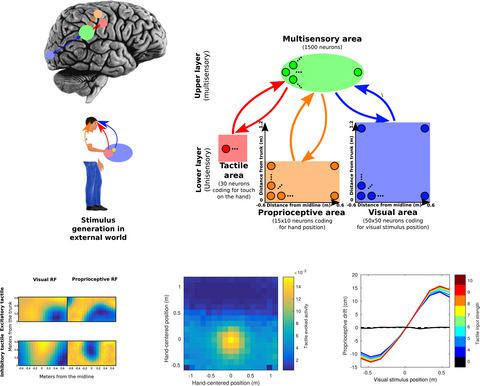当前位置:
X-MOL 学术
›
Eur. J. Neurosci.
›
论文详情
Our official English website, www.x-mol.net, welcomes your
feedback! (Note: you will need to create a separate account there.)
From statistical regularities in multisensory inputs to peripersonal space representation and body ownership: Insights from a neural network model
European Journal of Neuroscience ( IF 2.7 ) Pub Date : 2020-09-23 , DOI: 10.1111/ejn.14981 Tommaso Bertoni 1 , Elisa Magosso 2 , Andrea Serino 1
European Journal of Neuroscience ( IF 2.7 ) Pub Date : 2020-09-23 , DOI: 10.1111/ejn.14981 Tommaso Bertoni 1 , Elisa Magosso 2 , Andrea Serino 1
Affiliation

|
Peripersonal space (PPS), the interface between the self and the environment, is represented by a network of multisensory neurons with visual (or auditory) receptive fields anchored to specific body parts, and tactile receptive fields covering the same body parts. Neurophysiological and behavioural features of hand PPS representation have been previously modelled through a neural network constituted by one multisensory population integrating tactile inputs with visual/auditory external stimuli. Reference frame transformations were not explicitly modelled, as stimuli were encoded in pre‐computed hand‐centred coordinates. Here we present a novel model, aiming to overcome this limitation by including a proprioceptive population encoding hand position. We confirmed behaviourally the plausibility of the proposed architecture, showing that visuo‐proprioceptive information is integrated to enhance tactile processing on the hand. Moreover, the network's connectivity was spontaneously tuned through a Hebbian‐like mechanism, under two minimal assumptions. First, the plasticity rule was designed to learn the statistical regularities of visual, proprioceptive and tactile inputs. Second, such statistical regularities were simply those imposed by the body structure. The network learned to integrate proprioceptive and visual stimuli, and to compute their hand‐centred coordinates to predict tactile stimulation. Through the same mechanism, the network reproduced behavioural correlates of manipulations implicated in subjective body ownership: the invisible and the rubber hand illusion. We thus propose that PPS representation and body ownership may emerge through a unified neurocomputational process; the integration of multisensory information consistently with a model of the body in the environment, learned from the natural statistics of sensory inputs.
中文翻译:

从多传感器输入的统计规律到人际空间表示和身体所有权:来自神经网络模型的见解
人身空间(PPS)是自我与环境之间的接口,由多感官神经元网络组成,其视觉(或听觉)感受野固定在特定的身体部位,触觉感受野覆盖相同的身体部位。PPS表示的神经生理和行为特征先前已经通过一个神经网络进行建模,该神经网络由一个将触觉输入与视觉/听觉外部刺激相结合的多感官群体构成。参考帧转换未明确建模,因为刺激是以预先计算的手为中心的坐标进行编码的。在这里,我们提出了一种新颖的模型,旨在通过包括编码手位置的本体感受群体来克服这一限制。我们从行为上证实了拟议架构的合理性,表明整合了体内本体感受信息以增强手部的触觉处理能力。此外,在两个最小的假设下,通过类似Hebbian的机制自发调整了网络的连接性。首先,可塑性规则旨在学习视觉,本体感受和触觉输入的统计规律。其次,这种统计规律仅仅是身体结构所施加的规律。该网络学会了整合本体感受和视觉刺激,并计算其手心坐标以预测触觉刺激。通过相同的机制,网络再现了与主观身体所有权有关的操作的行为关联:看不见的和橡胶的手的幻觉。因此,我们建议通过统一的神经计算过程可能会出现PPS表示和身体所有权。从感官输入的自然统计中了解到,多感官信息的集成与环境中的人体模型一致。
更新日期:2020-09-23
中文翻译:

从多传感器输入的统计规律到人际空间表示和身体所有权:来自神经网络模型的见解
人身空间(PPS)是自我与环境之间的接口,由多感官神经元网络组成,其视觉(或听觉)感受野固定在特定的身体部位,触觉感受野覆盖相同的身体部位。PPS表示的神经生理和行为特征先前已经通过一个神经网络进行建模,该神经网络由一个将触觉输入与视觉/听觉外部刺激相结合的多感官群体构成。参考帧转换未明确建模,因为刺激是以预先计算的手为中心的坐标进行编码的。在这里,我们提出了一种新颖的模型,旨在通过包括编码手位置的本体感受群体来克服这一限制。我们从行为上证实了拟议架构的合理性,表明整合了体内本体感受信息以增强手部的触觉处理能力。此外,在两个最小的假设下,通过类似Hebbian的机制自发调整了网络的连接性。首先,可塑性规则旨在学习视觉,本体感受和触觉输入的统计规律。其次,这种统计规律仅仅是身体结构所施加的规律。该网络学会了整合本体感受和视觉刺激,并计算其手心坐标以预测触觉刺激。通过相同的机制,网络再现了与主观身体所有权有关的操作的行为关联:看不见的和橡胶的手的幻觉。因此,我们建议通过统一的神经计算过程可能会出现PPS表示和身体所有权。从感官输入的自然统计中了解到,多感官信息的集成与环境中的人体模型一致。











































 京公网安备 11010802027423号
京公网安备 11010802027423号